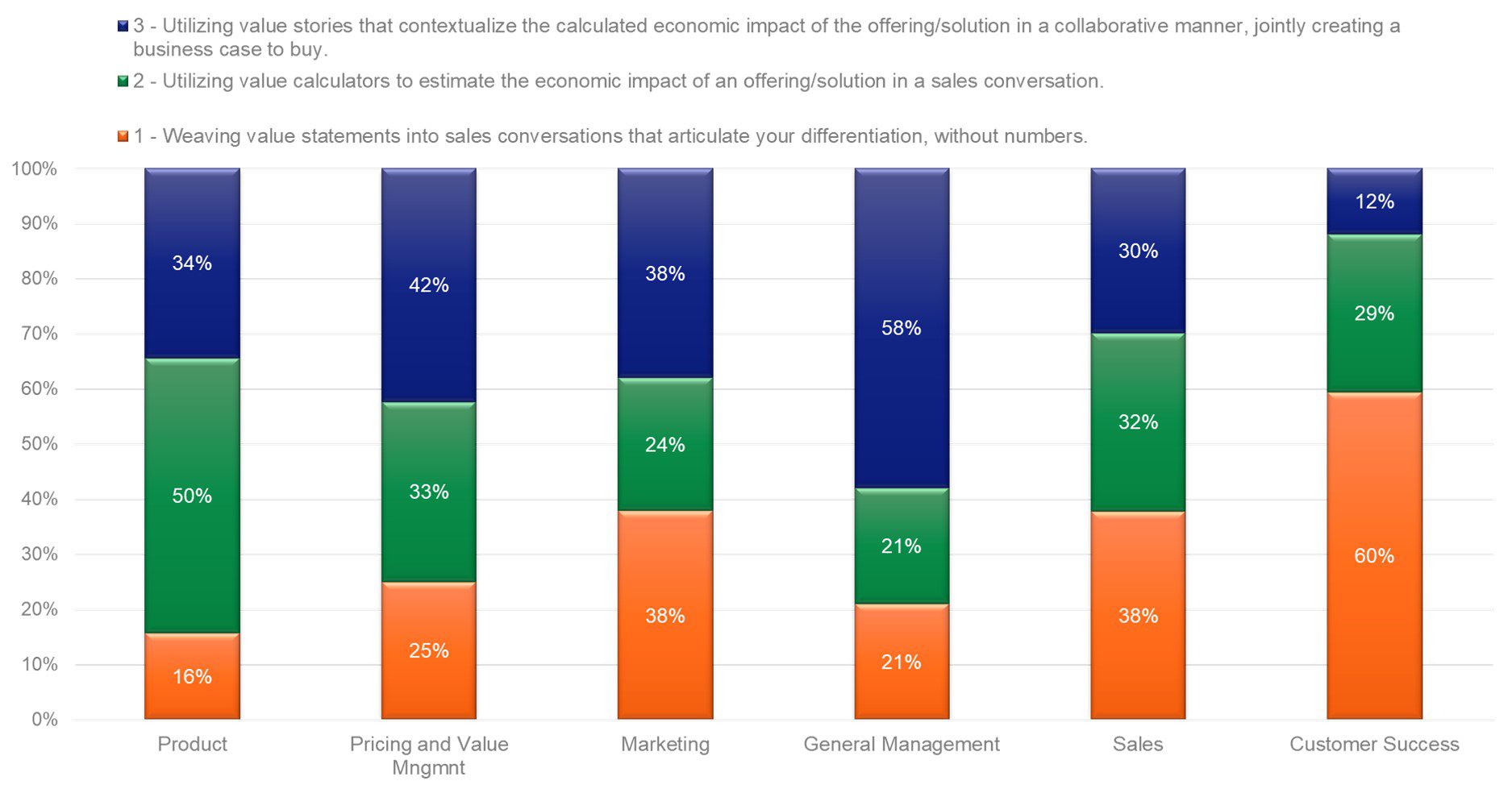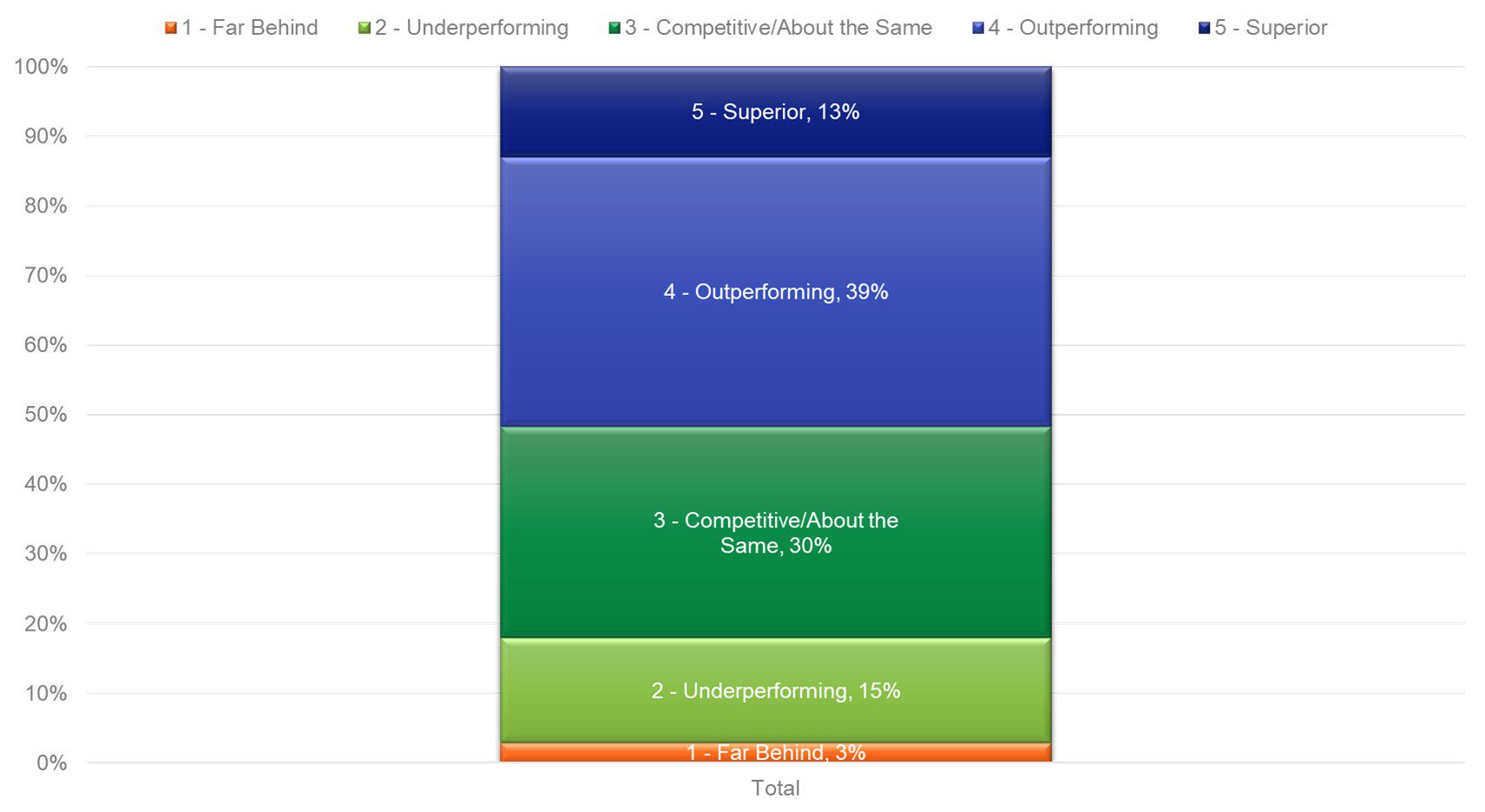When putting together the inaugural LeveragePoint State of Value Survey, we hoped to understand how a range of B2B professionals define and assess foundational aspects of their value management programs. In this blog we will focus on two broad questions:
- Key definitions: How does our audience define elemental concepts related to value?
- Performance: How do respondents rate the success of their value management programs?
By tackling these questions first, we hoped to learn more about how respondents felt about their experiences with customer value at a high level, before drilling into more specific ways they are currently deploying it in their commercial processes. Those findings will be covered across the next several posts.
What is Value Management?
The words we use heavily impact how we think about value. Clear definitions of value concepts are essential for communicating with peers and other stakeholders who may understand each of them differently. Through these questions, we hoped to better grasp the way our audience defines three interrelated concepts: value management, value proposition, and value selling. For each of the three concepts, we offered three definitions of increasing levels of maturity – from utilizing statement-level differentiation to successfully communicating quantified value – and asked respondents to indicate which most closely resembled their organization’s definition.
Analysis of survey findings points to instructive (and material) differences in understanding value concepts, especially across job function.
- Value Management: Our options ranged from using qualitative statements for internal use on one end to systematically deploying quantitative value in the commercial process. Overall, marketing and customer success professionals tended to look at value management as simply a training and planning process, whereas product, pricing, and sales came down more heavily on the [more mature] side of value management as a commercial practice, even if they emphasized qualitative and messaging elements. Meanwhile, general management thought of value management as about quantifying and communicating (65%). This was an intuitive finding to our experts:“From a general management perspective, you can’t get paid for [the value you create] and do number three if you don’t do the other two,” observed Snelgrove, “[quantifying and communicating customer value] is a discipline across the total organization and we need to look at it that way for us to truly make it happen. It is not about marketing throwing it over the wall to sales and over the wall to the product management and everybody blaming the other person of why value is not getting paid.”

- Value Proposition: Next, we tried to get a sense of how our audience defined what a ‘value proposition’ is. The range of answers again spans the spectrum from qualitative messages about differentiation, to a stronger quantitative approach using calculators, to an integrated story that includes both qualitative and quantitative elements. Again, we found that marketing and customer success are at the qualitative end of the spectrum, with 33% and 45% selecting the least mature option. (In the case of marketing, it is worth considering that this is consistent with how it is defined in many messaging frameworks). We also found it interesting that sales emphasized the calculator element (52% of respondents) while general management is again thinking about this as an integrated story (84%).Our panel emphasized the importance of combining the quantitative and qualitative. “To me, a value proposition communicates your product’s unique benefits or differentiation,” said Prebensen. “Numbers must be a part of a value proposition.” He continued, “I am not surprised to see that management defines a value proposition by the word ‘persuasive.’ In that context, it is not only the financial and economic impact but also the intangibles defined [by the value proposition].”

- Value Selling: We finally asked our audience how they defined value selling. Again, the answers range from the qualitative (incorporating value statements in sales) to the utilization of calculators and, finally, an integrated quantitative and qualitative approach. We found that general management comes down hard on the side of it being a story with math, while product, pricing, and sales mostly believe that math should be an element, and customer success and marketing are again more qualitative.“It is actually a mix of the three components mentioned here, shared de Angeli. “It is like an evolution. You start with a simple statement – a value proposition. Then moving to a quantification of what this statement is about, which already makes the difference because you can prove that your customer is making more money with you than with the next best alternative, then build the full value story, which is a part of your [sales] communication that is very, very important.

How Successful Are Our Value Management Initiatives?
Overall, our audience felt confident in the execution of their value management initiatives relative to their peer organizations. A majority of respondents – 52% – indicated that they were clearly superior or outperforming, with an additional 30% claiming to be competitive or about the same. In practice, it is not possible for a majority of companies to outperform their peers in this or any measure. However, the value-oriented nature of our survey audience suggests that the practice of embedding customer value in developing offerings and bringing them to market may be giving them confidence in their ability to outexecute similar organizations that lack this focus.

It is striking where this confidence is coming from within the organizational hierarchy. We found that there is a big difference in self-assessment between senior management and the frontline contributors and managers that are in the trenches. Overall, 68% of decision-makers (director-level and above) believe that they are outperforming, whereas only 36% of contributors in a mid-management position share that view.

What explains this gulf in sentiment about the success of value management initiatives between these two groups? Our panel of value experts shared their thoughts:
- Missed opportunities for greater adoption and impact. “I am not surprised about the confidence as I have been on both sides of these two columns, shared Ole Iacob Prebensen, Global Marketing Manager at Elkem. “I do think there is some wishful thinking in all of this – what this result really shows is a clear difference between what [management] wishes for and what is actually being done. Just because value-based management or pricing has been implemented, it does not mean that the entire organization has adopted the right mindset. Most of the time upper management will look purely at financial results and they do not necessarily see what they could have been if they went all in with value-based management.”
- Management sees an incomplete picture of success. “Sometimes we only want to tell the good stories going up,” shared Todd Snelgrove, Founding Partner at Experts in Value. “So as management, everything I hear is great [when we win]. When we do not use it or when we lost there is always another reason – it is never because of value or lack of doing our job [selling value]. As salespeople we are good at value – so we think. So, there can be a bit of selection bias.”
- Lack of value champions leads to a lack of sales confidence. “How many companies have really spent time discussing with customers a differential value proposition rather than simply having an internal exercise on the value proposition and considering that good enough,” asked Paolo de Angeli, Head of Customer Experience and Customer Value Management at Borealis. “What I observe is that the earlier you involve people in the field that eventually need to bring [value propositions] to customers, the better it is. This sounds so obvious, but it is still a very common mistake. And if you do not make this mistake, you are already ahead of the competition because if you have champions [supporting sales] from the beginning. Marketing defines the value proposition, and sales brings it to market and to the customers. It should be really a joint effort.”
What have we learned? There is a range of perspectives, especially between job functions, pertaining to the definitions of basic value management concepts. We therefore need to be especially careful to define what we mean when implementing value management initiatives to align these perspectives into a shared company-wide vision. Experts advocate that value must have both a strong narrative aspect (what are the key features and benefits customers realize in our offerings) as well as a strong quantitative component (wherein we calculate the level of benefits derived.
Similarly, in evaluating the performance of value initiatives, we need to be careful to reconcile the views of upper-level management with those who are on the front lines. Clear metrics and performance measures are key, as well as developing a learning culture where it is safe to identify opportunities for future improvement. To this end, it is critical that senior management empowers mobilizers to help generate sales adoption, and foster a culture of transparency that enables customer-facing team members to identify areas of improvement and opportunities for expansion.
When are you applying value management in your new product development, product management, and go-to-market processes? How does your organization deploy value management and value selling? Stay tuned for the next updates in this series, where we will dig into:
-
- When is customer value utilized in making decisions for new and existing offerings?
- When in the sales process are value selling tactics deployed?
- How are leading companies embedding customer value in the sales process?
- What are some useful ways for individuals and organizations to improve their value management efforts?
- Survey Overview

